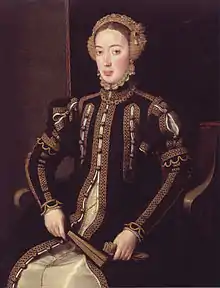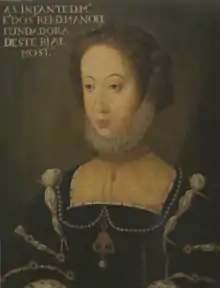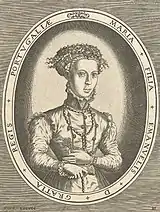Maria of Portugal, Duchess of Viseu
Maria of Portugal, Duchess of Viseu (18 June 1521 – 10 October 1577; Portuguese pronunciation: [mɐˈɾiɐ]) was an Infanta of Portugal, the only daughter of King Manuel I of Portugal and Eleanor of Austria. A noted patron of the arts and buildings, Maria's personal wealth rivaled that of her half-brother, King John III of Portugal, making her the richest woman in Portugal and one of the wealthiest princesses in Europe.
| Maria of Portugal | |
|---|---|
| Duchess of Viseu | |
 Anthonis Mor (c. 1550–1555) | |
| Born | 18 June 1521 Lisbon, Kingdom of Portugal |
| Died | 10 October 1577 (aged 56) Lisbon, Kingdom of Portugal |
| Burial | Church of Our Lady of Luz, Lisbon |
| House | Aviz |
| Father | Manuel I of Portugal |
| Mother | Eleanor of Austria |
| Religion | Roman Catholicism |
Youth

Maria de Avíz was born on 18 June 1521, in Lisbon, Portugal. She was the only daughter of King Manuel I of Portugal and Archiduchess Eleanor of Austria. Six months after her birth, her father died of the plague and was succeeded by her half-brother, John III of Portugal. Shortly afterwards, her mother returned to Vienna with Maria until 1530, when Eleanor was married King Francis I of France and moved to France. Maria would not see her mother for nearly 28 years and was sent to live in Portugal at her half-brother's court.
In 1525, her maternal aunt Catherine of Austria, was married John III of Portugal. The Queen took care of the upbringing and education of Maria, who was loved like one of her own daughters. Their education was astounding for a woman of their time since their teaches included female scholars, such as humanists Joana Vaz and Públia Hortênsia de Castro. Lessons included finances, architecture, literature, and several languages. One of the most educated of the Portuguese infantas, Maria became a famed humanist and protector of the arts.[1] Her household was made into a sort of female university, where the greatest minds would converge. It was rumored that she fell in love with Portugal's greatest poet, Luís de Camões.
Although she did not lack suitors and had several marriage proposals, Maria never married. Her engagament with Dauphin Francis was negotiated with the support of her mother Eleanor, but the prince died in 1536. In 1537, Maria and her cousin Christina, Dowager Duchess of Milan, were briefly considered as possible brides for Henry VIII of England. However, England soon dropped any pursuit. Maria was considered as a second wife for her cousin and half-nephew, the future Philip II of Spain,[2] son of her uncle, Emperor Charles V, and her half-sister Isabella, The matter was taken to serious consideration from 1549 onward, when her mother settled in Brussels, but these plans were discontinued when Mary Tudor succeeded to the English throne in 1553 and Charles V decided to marry his son Philip to a monarch.[3] Other candidates for her hand were Archduke Maximilian of Austria; his father Ferdinand I, Holy Roman Emperor; and the Duke of Savoy.
Duchess of Viseu


Eventually, King John III gave Maria her own household and the duchy of Viseu, the state their father owned before he became King. Under her rule, the city continued and prospered its several industries of pottery, embroidery and copper. Her personal wealth eventually rivaled that of the king, making her the richest woman in Portugal and one of the wealthiest princesses in Europe.
Receiving such incomes, Maria sponsored several building projects, particularly in Carnide and the Lisbon countryside. She financed and supervised the construction of the Church of Nossa Senhora da Luz and the Hospital of Nossa Senhora dos Prazeres, which currently houses the Colégio Militar, both of which still boast large reliefs of her personal coat of arms. In Lisbon, she sponsored the construction of the Church of Santa Engrácia, in São Vicente. The original structure she ordered to be built would be completely destroyed in 1681, which would lead to the construction of the new current church, which now serves as the National Pantheon of Portugal.
Later life
After her half-brother John's death in 1558, Maria went to Spain to meet her widowed mother for the first time in 28 years. Eleanor asked her unwed daughter to come and live with her and her aunt Mary, but Maria refused the request and only remained there for three weeks before returning to Lisbon. Eleanor died very shortly afterwards on her return journey to Jarandilla de la Vera from Badajoz.
During the tumultuous period of the minority of young King Sebastian, a faction of the Portuguese nobility wanted that the Duchess of Viseu would replace Queen Dowager Catherine as regent, but these plans came to nothing. Maria died in Lisbon on October 10, 1577, at the age of 56. She was buried in the Church of Nossa Senhora da Luz.
Ancestry
| Ancestors of Maria of Portugal, Duchess of Viseu | ||||||||||||||||||||||||||||||||||||||||||||||||||||||||||||||||||||||||||||||||||||||||||||||||||||||||||||||||||||||||||||||||||||||||||||||||||||||||||||||||||||||||||||||||||||||||||||||||||||||||||||||||||||||||||||||||||||||||||||||||||||||||||||||||||||||||||||||||||||||||||||||||||||||||||||||||||||||||||||||||||||||||||||||||||||||||||||||||||||||||||||||||||||||||||||||||||||||||||||||||||||||||||||||||||||||||||||||||||||||||||||||||||||||||||||||||||||||||||||||||||||||||||||||||||||||||||||||||||||||||||||||||||||||||||||||||||||||||||||||||||||||||||||||||||||||||||||||||
|---|---|---|---|---|---|---|---|---|---|---|---|---|---|---|---|---|---|---|---|---|---|---|---|---|---|---|---|---|---|---|---|---|---|---|---|---|---|---|---|---|---|---|---|---|---|---|---|---|---|---|---|---|---|---|---|---|---|---|---|---|---|---|---|---|---|---|---|---|---|---|---|---|---|---|---|---|---|---|---|---|---|---|---|---|---|---|---|---|---|---|---|---|---|---|---|---|---|---|---|---|---|---|---|---|---|---|---|---|---|---|---|---|---|---|---|---|---|---|---|---|---|---|---|---|---|---|---|---|---|---|---|---|---|---|---|---|---|---|---|---|---|---|---|---|---|---|---|---|---|---|---|---|---|---|---|---|---|---|---|---|---|---|---|---|---|---|---|---|---|---|---|---|---|---|---|---|---|---|---|---|---|---|---|---|---|---|---|---|---|---|---|---|---|---|---|---|---|---|---|---|---|---|---|---|---|---|---|---|---|---|---|---|---|---|---|---|---|---|---|---|---|---|---|---|---|---|---|---|---|---|---|---|---|---|---|---|---|---|---|---|---|---|---|---|---|---|---|---|---|---|---|---|---|---|---|---|---|---|---|---|---|---|---|---|---|---|---|---|---|---|---|---|---|---|---|---|---|---|---|---|---|---|---|---|---|---|---|---|---|---|---|---|---|---|---|---|---|---|---|---|---|---|---|---|---|---|---|---|---|---|---|---|---|---|---|---|---|---|---|---|---|---|---|---|---|---|---|---|---|---|---|---|---|---|---|---|---|---|---|---|---|---|---|---|---|---|---|---|---|---|---|---|---|---|---|---|---|---|---|---|---|---|---|---|---|---|---|---|---|---|---|---|---|---|---|---|---|---|---|---|---|---|---|---|---|---|---|---|---|---|---|---|---|---|---|---|---|---|---|---|---|---|---|---|---|---|---|---|---|---|---|---|---|---|---|---|---|---|---|---|---|---|---|---|---|---|---|---|---|---|---|---|---|---|---|---|---|---|---|---|---|---|---|---|---|---|---|---|---|---|---|---|---|---|---|---|---|---|---|---|---|---|---|---|---|---|---|---|---|---|---|---|---|---|---|---|---|---|---|---|---|---|---|---|---|---|---|---|---|---|---|---|---|---|---|---|---|---|---|---|---|---|---|---|---|---|---|---|---|---|---|---|---|---|---|---|---|---|---|---|---|---|---|---|---|---|---|---|---|---|---|---|---|---|---|---|---|---|---|---|---|---|---|---|---|---|---|---|---|---|---|---|---|---|---|---|---|---|---|---|---|---|---|---|---|---|---|---|---|---|---|---|---|---|---|---|---|---|---|---|---|---|---|---|---|---|---|---|---|---|---|---|
| ||||||||||||||||||||||||||||||||||||||||||||||||||||||||||||||||||||||||||||||||||||||||||||||||||||||||||||||||||||||||||||||||||||||||||||||||||||||||||||||||||||||||||||||||||||||||||||||||||||||||||||||||||||||||||||||||||||||||||||||||||||||||||||||||||||||||||||||||||||||||||||||||||||||||||||||||||||||||||||||||||||||||||||||||||||||||||||||||||||||||||||||||||||||||||||||||||||||||||||||||||||||||||||||||||||||||||||||||||||||||||||||||||||||||||||||||||||||||||||||||||||||||||||||||||||||||||||||||||||||||||||||||||||||||||||||||||||||||||||||||||||||||||||||||||||||||||||||||
See also
References
| Wikimedia Commons has media related to Maria de Portugal, Duquesa de Viseu. |
- Paulo Pereira, Enciclopédia dos Lugares Mágicos de Portugal, volume IX
- Juan de Mariana: Historia general de España, vol. XIV
- Julia Cartwright: Christina of Denmark. Duchess of Milan and Lorraine. 1522–1590, New York, 1913
- Stephens, Henry Morse (1903). The Story of Portugal. G.P. Putnam's Sons. p. 139. Retrieved 17 September 2018.
- de Sousa, Antonio Caetano (1735). Historia genealogica da casa real portugueza [Genealogical History of the Royal House of Portugal] (in Portuguese). 2. Lisboa Occidental. p. 497.
- de Sousa, Antonio Caetano (1735). Historia genealogica da casa real portugueza [Genealogical History of the Royal House of Portugal] (in Portuguese). 2. Lisboa Occidental. p. 167.
- Liss, Peggy K. (10 November 2015). Isabel the Queen: Life and Times. University of Pennsylvania Press. p. 11. ISBN 9780812293203.
- Holland, Arthur William (1911). . In Chisholm, Hugh (ed.). Encyclopædia Britannica. 17 (11th ed.). Cambridge University Press.
- Wurzbach, Constantin, von, ed. (1861). . Biographisches Lexikon des Kaiserthums Oesterreich [Biographical Encyclopedia of the Austrian Empire] (in German). 7. p. 112 – via Wikisource.
- Wurzbach, Constantin, von, ed. (1860). . Biographisches Lexikon des Kaiserthums Oesterreich [Biographical Encyclopedia of the Austrian Empire] (in German). 6. p. 160 – via Wikisource.
- Poupardin, René (1911). . In Chisholm, Hugh (ed.). Encyclopædia Britannica. 5 (11th ed.). Cambridge University Press.
- Chisholm, Hugh, ed. (1911). . Encyclopædia Britannica. 10 (11th ed.). Cambridge University Press.
- Chisholm, Hugh, ed. (1911). . Encyclopædia Britannica. 15 (11th ed.). Cambridge University Press.
- Chisholm, Hugh, ed. (1911). . Encyclopædia Britannica. 14 (11th ed.). Cambridge University Press.
Maria of Portugal, Duchess of Viseu Born: 18 June 1521 Died: 10 October 1557 | ||
| Portuguese nobility | ||
|---|---|---|
| Vacant Title last held by Manuel I of Portugal |
Duchess of Viseu | Vacant Title next held by Prince Miguel, Duke of Viseu |